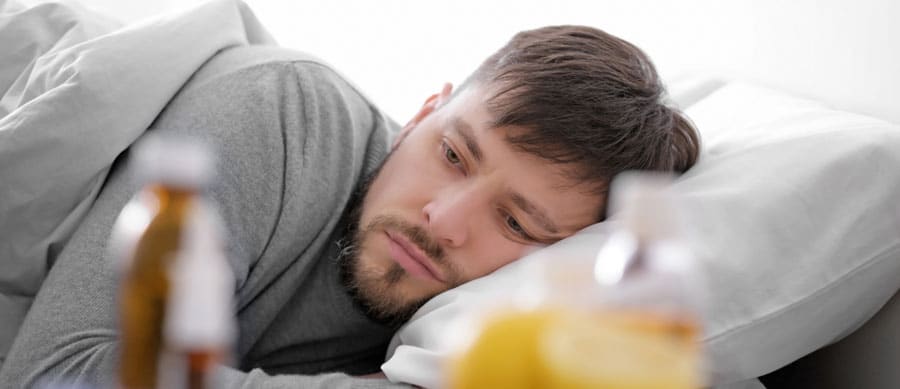Updated on April 7th, 2021
Opioid addiction is a widespread problem in America and if you find yourself hooked on your prescription painkillers or heroin, you’re not alone. While there are many benefits to getting sober, opioid withdrawal can be a painful and difficult process, especially without professional support.
An inpatient medical detox program for opioid addiction is often the safest and most effective option for getting sober, but if you don’t have health insurance or are financially unable to pay for treatment, detoxing at home may seem like the next best option.
In this blog, we’ll provide details about the possible risks of detoxing from opioids at home as well as tips on how to do so safely, if you decide to. However, it’s important to note that at-home opioid detox is never recommended and inpatient detox treatment is always safest.
Table of contents
- Is Home Opiate Detox Safe?
- What Are the Risks of At-Home Opioid Detox?
- What is the Success Rate for At-Home Opioid Detox?
- At-Home Opioid Detox: Pros and Cons
- How to Detox from Painkillers at Home
- How to Help a Loved One Detox From Opioids
- What Are Alternatives to At-Home Opioid Detox?
- Find Safe and Effective Opioid Detox in Austin and Houston
Is Home Opiate Detox Safe?
No, home opiate detox is not safe. The idea of detoxing at home is a comforting one, especially if you’re anticipating experiencing the uncomfortable side effects of opioid withdrawal. However, detoxing from opioids on your own at home can not only be very dangerous, but it may also be life-threatening.
Unfortunately, the complications of opioid withdrawal are often underestimated and people rarely have the medical and clinical support they need to safely and adequately recover.1
The severity of opioid withdrawal symptoms is subjective, but generally, people report that it feels like having the flu. Common symptoms of opioid withdrawal include:
- Dysphoria
- Insomnia
- Dilated pupils
- Yawning
- Muscle aches
- Chills
- Nausea and vomiting
- Fever
- Sweating
- Abdominal cramping
- Diarrhea
- Teary eyes
- Agitation
- Runny nose2
If you are severely addicted to opioids and you experience withdrawal symptoms when you try to stop using or cut back, the addiction treatment professionals at Briarwood do not recommend detoxing from opioids on your own at home. Inpatient treatment is the safest option for opioid detox.
What Are the Risks of At-Home Opioid Detox?
Although opioid detox and withdrawal is a very individualized process and each person will experience it differently, there are several very real risks of detoxing from opiates on your own.
- Unpredictable withdrawal symptoms: As mentioned above, opioid withdrawal is a highly individualized process. Depending on factors like the person’s overall health, the size of the dose each time they used, how long they’ve been using opioids, whether they used other drugs or alcohol with the opioids, and several other factors, they may experience unpredictable physical and psychological side effects of withdrawal.
- High likelihood of relapse: Without the professional support of a medical and clinical treatment team, a person detoxing from opioids at home is likely to relapse. Opioid withdrawal can be very uncomfortable, and without medical treatment for those symptoms, a person could easily revert back to abusing opioids simply to get relief.
- Death: Death caused by opioid withdrawal is very possible. Persistent vomiting and diarrhea left untreated can cause severe dehydration, an elevated blood sodium level, and heart failure as a result.1 Fortunately, opioid withdrawal deaths are highly preventable with medical support and treatment during detox.
- Lack of direction after detox: Even if a person successfully detoxes from opioids at home, a lack of support and direction in sobriety can lead them right back into regular drug abuse. On the other hand, a medical detox treatment program can provide personal recommendations for ongoing treatment in rehab and help the client through the enrollment process to ensure a smooth transition.
What is the Success Rate for At-Home Opioid Detox?
It is difficult to determine a success rate for at-home opioid detox because the definition of “successful opioid detox” varies from person to person. For example, if someone gets sober but then relapses, was the detox successful? Or, if a person detoxes from opioids at home but then starts abusing other substances to deal with chronic pain or life circumstances, are they really any better off?
Ultimately, if your goal is to stop abusing opioids, get sober, and stay sober, inpatient medical detox is the most effective, most comfortable, and safest way to do so.
At-Home Opioid Detox: Pros and Cons
| PROS | CONS |
|
|
How to Detox from Painkillers at Home
If you plan to detox from opiates on your own at home, you’ll need to be prepared. Opioid withdrawal can be very difficult, especially without professional treatment and support. Most people find it extremely difficult to self-regulate the tapering process, which often results in a full relapse into opioid addiction.
We never recommend trying to detox from opioids on your own, as opioid withdrawal can be dangerous without professional treatment. However, if you choose to do so, you might be wondering about home remedies for opiate withdrawal. There are certain things you can do to relieve uncomfortable withdrawal symptoms.3
- Fever, chills, sweating, and muscle aches can be treated with over-the-counter medications like ibuprofen and acetaminophen.
- Using cool compresses and ice packs can reduce a high temperature.
- Research shows St. John’s Wort may help reduce shaking, diarrhea, depression, and insomnia.4 However, this herb is also known to interact negatively with many other medications, so it should be used with caution.
- Imodium, an over-the-counter medication, may be used to treat diarrhea.
- Eating small meals, bland food, and regularly drinking small sips of water can help treat nausea and prevent dehydration.
- Melatonin, another over-the-counter supplement, may help treat insomnia, although it doesn’t always work for all individuals.
Additionally, here are a few tips that may help improve your mental health while you detox from opioids.
- Lots of distractions: Opioid detox is no walk in the park. Keeping your mind busy by reading books or watching movies can help combat cravings. You should also do your best to stay comfortable while you detox, so stay in bed if you need to and plan of having extra bedding ready nearby (due to excessive sweating during opioid withdrawal).
- Support person/people: Detoxing on your own is challenging but having a support person (or people) with you while you detox can help you get through it successfully. A support person can help distract you from your cravings, administer over-the-counter medications if you are unable, and call 911 if you need emergency care at any point during the process.
- Relax outdoors: Once you’re feeling up to it, getting outside for a brief and easy walk or even just sitting outside with a book may help you relax. Any outdoor activities that boost your endorphins will help you feel better despite any lingering psychological withdrawal symptoms.
Your safety is a serious concern if you choose to detox from opioids at home. We highly recommend being cautious about the advice and recipes shared on online forums. These methods have not been tested for efficacy or safety.
How to Help a Loved One Detox From Opioids
Wondering how to help someone detox at home? Here are some tips to make the process more feasible.
- Take your loved one to the doctor: Before your loved one begins detoxing from opioids, you should take them to the doctor. He or she may provide medical assistance to help. You can also get contact information or phone numbers to call if something goes wrong while your friend is detoxing.
- Have patience: During detox, your loved one will likely say some hurtful things to you, beg you to get them drugs, or tell you that they are dying (even if their withdrawal symptoms are mild). This type of behavior is normal but can be difficult to deal with if you’re not prepared to have patience.
- Help them stay comfortable: To help your loved one remain comfortable during detox, you may need to administer over-the-counter medications, change bedsheets, and provide clean towels and blankets. Your loved one will sweat, shake, and shiver during opioid detox, so keeping their clothing and linens dry will be an enormous help.
- Seek detox treatment: Rather than taking the risk of detoxing at home, you can seek out an opioid detox program that will help your loved one safely and comfortably get through withdrawal. Treatment at a detox center will also help them establish a firm foundation for their recovery.
What Are Alternatives to At-Home Opioid Detox?
If you decide that at-home opioid detox is just not worth the risk, medical detox is an excellent alternative. Enrolling in an inpatient opioid detox program will ensure your safety, comfort, and a successful detoxification process.
During opioid detox, medical and clinical addiction treatment professionals will coordinate to provide detox treatment that is tailored to your individual needs. This means, as your physical and psychological symptoms change, your treatment team will adjust your treatment to make sure you are comfortable and well-cared-for at all times.
Our Austin medical detox center and Houston drug detox center are also designed to feel like home so you can feel comfortable and safe while you rest. You’ll also receive chef-prepared meals that are delicious and well-balanced to enhance your physical recovery. After you complete your program, your treatment team will provide professional recommendations for ongoing care to give you the best chance at sustained, long-term sobriety. Examples of continuing care programs could include residential rehab, outpatient rehab, IOP, or a sober living program.
During detox at Briarwood, you’ll also have the opportunity to attend H&I meetings. These group sessions are low-pressure, informal introductions to the 12-Step Program. You’ll have the chance to listen to peers in recovery as they share their personal stories and connect with other like-minded people.
Find Safe and Effective Opioid Detox in Austin and Houston
At-home opioid detox and withdrawal are physically and psychologically challenging, as well as unsafe. Fortunately, it’s not the only route to sobriety and recovery. An opioid detox program can provide the professional and peer support you need to fully recover.
References:


